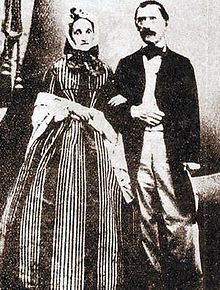You can help expand this article with text translated from the corresponding article in German. (October 2012) Click for important translation instructions.
|

Jakob Christof Rad (Anglicised Jacob Christoph Rad, Czech: Jakub Kryštof Rad; 25 March 1799 – 13 October 1871) was a Swiss-born Austrian physician and industrial manager. He had many other professional activities, was a director of a sugar factory in Dačice, Bohemia, Austria-Hungary (now the Czech Republic) in 1843, and invented the process and associated machinery for cutting large block sugar into manageable uniform pieces. Rad is credited with the invention of sugar cubes.
Biography
Rad was born on 25 March 1799 in Rheinfelden, Switzerland. He was the father of 16 children. He died in 1871 in Vienna.
Invention of the cube sugar

Rad is credited with the invention of sugar cubes. The idea to produce sugar in cube form came from his wife, who cut herself while paring down the standard large, commercial sugar loaf into smaller parts for use in the home. Rad had become involved with management of a sugar factory in 1840 in the South Bohemian town of Dačice (present day Czech Republic). He began work on a machine for transforming sugar into cube form, leading to a five-year patent for the cube press he invented, granted on 23 January 1843. Rad had started a business producing the "tea sugar" that was ultimately unsuccessful. The factory set up in Dačice went into bankruptcy, Rad returned to Vienna in 1846, production stopped, the invention was forgotten. The sugar cubes were successfully mass-produced 30 years later using a different process.
References
- "Rengeteg háztartási balesetet előzött meg az új találmány. Immár 176 éve életünk része" [The new invention prevented many household accidents. It has been part of our lives for 176 years now.]. promotions.hu (in Hungarian). 2019. Retrieved 13 March 2023.
- Potthast, Jan (2023). "An invention that sweetened everyday life". dpma.de. Retrieved 13 March 2023.
- ^ Grigorieva, Alexandra (2015). "sugar cubes". The Oxford Companion to Sugar and Sweets. Oxford University Press. doi:10.1093/acref/9780199313396.001.0001. ISBN 978-0-19-931339-6.
- Drahoňovská, Lucie Pantazopoulou (2018). "From Round to Square". Fehler. Goethe-Institut. Retrieved 2 October 2023.
Further reading
- Late 18th century Swedish sugar chest (display) referencing Rad's invention, at Deutsches Technikmuseum.
- M. Habacher: "Rad Jakob Christof". In: Österreichisches Biographisches Lexikon 1815–1950 (ÖBL). Vol. 8, Austrian Academy of Sciences, Vienna 1983, ISBN 3-7001-0187-2, p. 366 f. (Direct links to "p. 366", "p. 367"), see also , accessed 7 July 2015. (in German)
- Was ist Zucker ? at the Wayback Machine (archived February 12, 2005) (in German)
- DZDF/Museum Dačice: Würfelzucker (in German)
- Archiv Reinhard Lämmel (in German)
- Würfelzucker (in German)
This business-related Austrian biographical article is a stub. You can help Misplaced Pages by expanding it. |